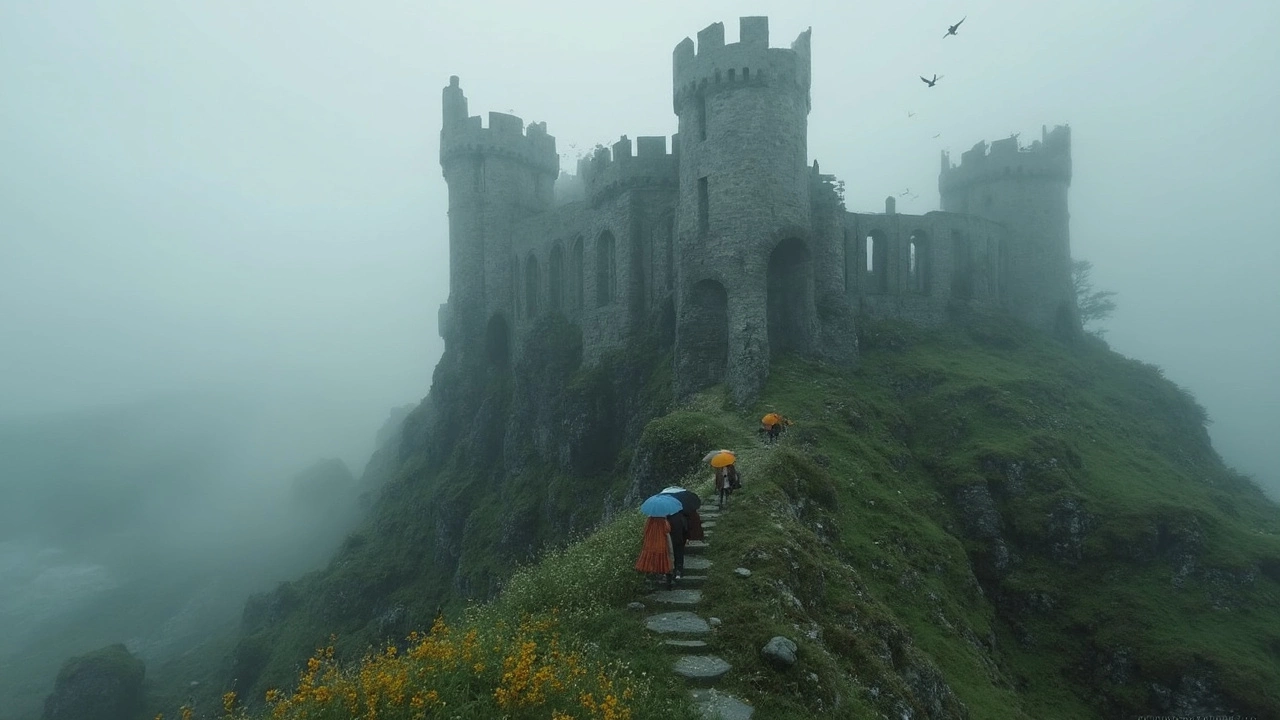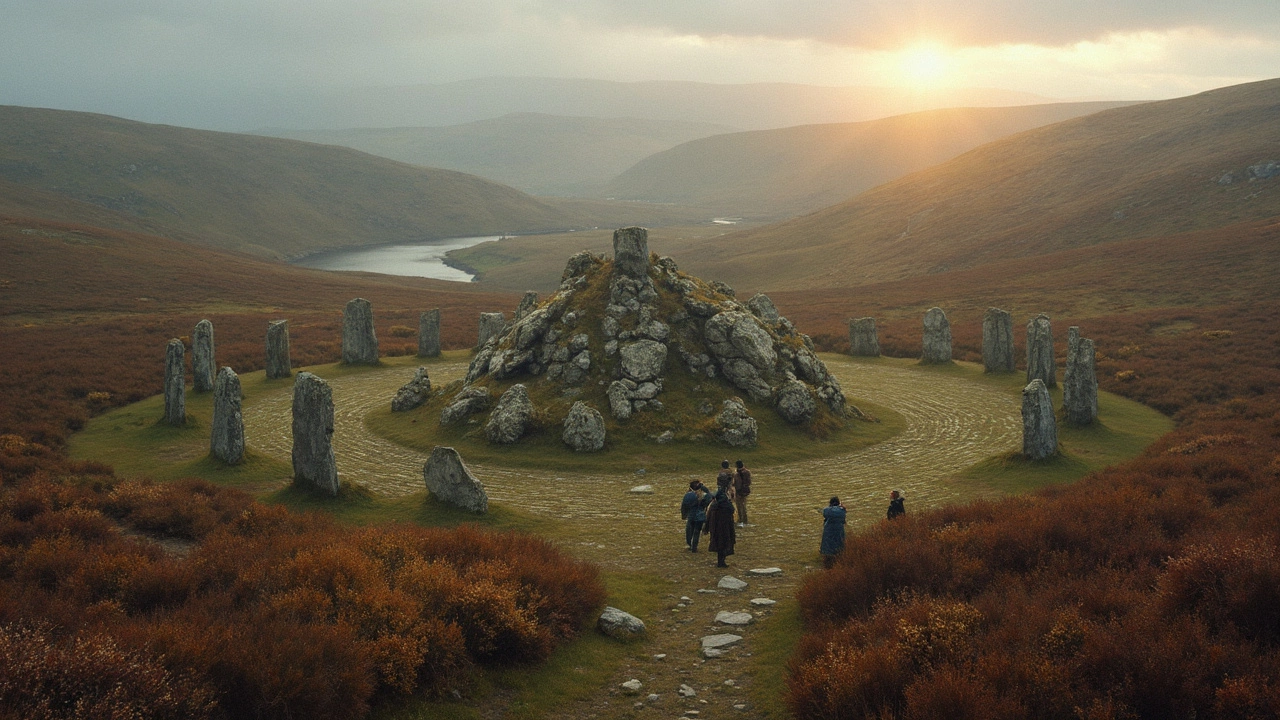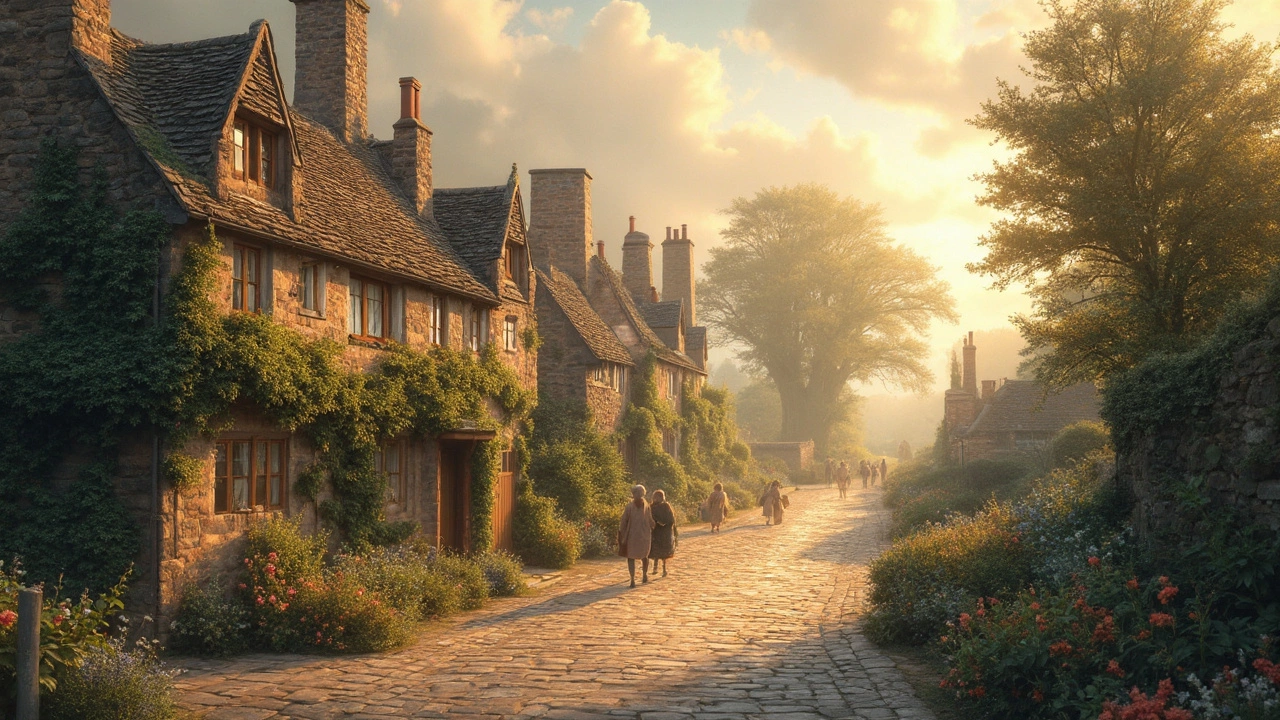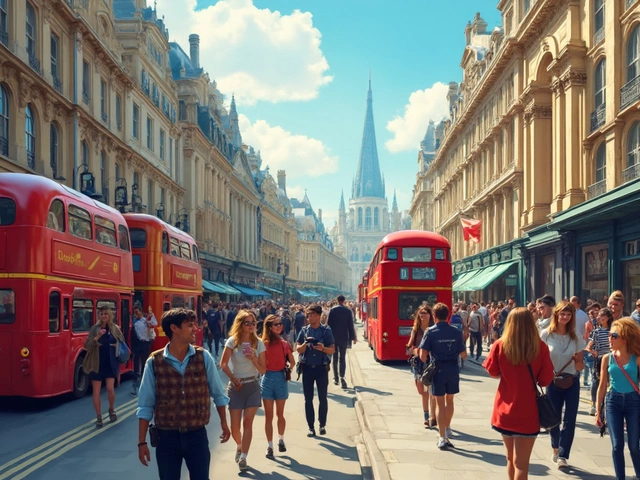There’s no shortage of places in the UK that feel like they belong in a fairytale. Whether it’s stumbling across a mossy ruin in the woods, wandering cobbled streets shrouded in morning fog, or hiking up hills where legends say giants once roamed—this country seems to collect magic in the oddest corners.
If you’ve ever felt the urge to just escape the daily grind and step somewhere out of time, the UK really delivers. We’re not just talking about the photos you see on Instagram that look too perfect; there are places you can go where the myths are woven into the scenery, and you honestly get those ‘goosebumps on your arms’ moments.
Of course, ‘magical’ is a bit personal. For me, it’s walking up to Glastonbury Tor at sunset, breathing in wild garlic in the West Woods outside Marlborough, and being totally gobsmacked by the last rays of light over Dunluce Castle in Northern Ireland. If you’re planning a trip and want to chase this kind of magic, you’re in for a treat. Keep reading for spots that have made even my cynical friends admit the UK has a bit of real-life Hogwarts hidden around every corner.
- What Makes a Place Magical?
- Legendary Landscapes and Enchanting Forests
- Charmed Villages and Hidden Corners
- Wondrous Castles and Ancient Ruins
- Tips for Experiencing Magic in the UK
What Makes a Place Magical?
Let’s be honest—when someone asks about the most magical places in the UK, they’re not looking for somewhere that’s just pretty. They want that feeling you get when a place feels like it has secrets, stories, or an extra bit of something you can’t quite explain. But there's more to a magical spot than just a nice backdrop for a selfie.
Usually, it’s the mix of history, legends, and nature that turns an ordinary place into something unforgettable. Think about the Scottish Highlands: you’ve got centuries-old castles, misty lochs that seem to hide monsters, and wild mountains that honestly look untouched. Or consider places like Stonehenge, which still baffles experts, and Glastonbury, where myths of King Arthur blend with real ancient ruins. It’s not just the stunning views; it’s the stories and atmosphere.
Locals often add to the magic. In the village of Portmeirion in Wales, for example, you’ll occasionally find locals in eccentric costumes thanks to quirky festivals. Or take Edinburgh’s Old Town—walk its winding alleys at dusk and you’ll hear tales of ghosts or body snatchers, told by guides who make it feel almost real. These things stick with you far longer than the view itself.
Weather plays into it too. Sometimes, places get their magical feel when fog rolls in, or a sudden burst of sunshine lights up ancient stonework. Anyone who’s spent time on the Cornish coast knows those wild, windy days make Tintagel Castle—said to be linked to Merlin—the stuff of legend.
- Historical roots: Places with a long, wild history tend to feel the most magical. The UK is packed with them.
- Local myths: When there’s a tale attached—whether it’s giants, fairies, or lost kings—the spot gets a whole new vibe.
- Unusual landscapes: Odd rock formations in the Peak District or eerie woodlands in Sussex make you feel like you’re somewhere truly different.
A truly magical place isn’t just beautiful; it gets under your skin. You leave feeling changed, even if you can’t put your finger on why. And that’s what makes discovering these places in the UK genuinely special.
Legendary Landscapes and Enchanting Forests
The UK just keeps surprising you with places where nature meets myth. Take the Lake District in Cumbria—this spot isn’t just famous because of poets and sheep. Walk up to Catbells or around Derwentwater and it’s easy to see why folks call it magical. William Wordsworth called it "the loveliest spot that man hath found."
Then there’s the Scottish Highlands, which sometimes feel more fantasy than fact. Glen Coe is probably the most photographed glen in the UK, with its misty mountains and hidden waterfalls. If you want drama, go here. You might even spot a red deer or two crossing the road like they own the place. Just keep a waterproof jacket handy!
When it comes to forests, you can’t beat Puzzlewood in Gloucestershire’s Forest of Dean. It gets all kinds of attention because scenes from Star Wars and Harry Potter were filmed here. The paths are twisty, the rocks go mossy green, and it’s almost impossible not to feel like you’re on a movie set. It’s a good pick for families too—kids (and adults, let’s be honest) get lost in all the secret tunnels.
If ancient trees are more your thing, check out Sherwood Forest in Nottinghamshire. Yes, that Sherwood—Robin Hood’s old haunt. The Major Oak here is roughly 1,000 years old and has a canopy that spreads out over 28 meters. They even have walking trails and an annual Robin Hood Festival if you’re into a bit of playful history with your hike.
Looking for something even older? Walk among the standing stones at Avebury in Wiltshire, not far from Stonehenge but, honestly, less crowded and you can actually touch the stones. The Avebury henge is the largest stone circle in the world and some of these stones have stood for over 4,500 years.
| Legendary Location | Region | Key Fact | Best Time to Visit |
|---|---|---|---|
| Lake District | Cumbria | UNESCO World Heritage Site since 2017 | May-September |
| Glen Coe | Scottish Highlands | Site of a famous volcanic event 350 million years ago | April-October |
| Puzzlewood | Gloucestershire | Featured in Star Wars and Harry Potter films | March-October |
| Sherwood Forest | Nottinghamshire | Home to the legendary Major Oak | All year, especially August for festival |
| Avebury | Wiltshire | Largest stone circle in the world | Spring and Autumn |
Here’s how to make the most of these magical places UK:
- Book ahead if you’re visiting during school holidays. These spots can get busy fast, especially Puzzlewood.
- Check the weather. British magic often comes with rain—pack for it.
- If you want quiet and moody photos, go early or late in the day when most crowds have gone home.
- At Avebury, walk the whole perimeter of the stones to spot hidden carvings and unusual animal tracks.
- Bring a friend or family member who loves a good ghost story—it’s never too early to start swapping silly legends.

Charmed Villages and Hidden Corners
Want to see those storybook villages where it honestly looks like time froze? The UK has loads of them, and each has its own quirky traditions and secrets. Bibury, often called the prettiest village in England, is famous for Arlington Row—these are 17th-century weavers’ cottages lined up along a gentle stream. A couple of years back, they tracked over 120,000 visitors in just one summer. It’s best to visit early in the morning if you want the place to yourself (and to avoid the crowds filling up the tiny cafés and tea rooms).
Then you’ve got Portmeirion in North Wales, and it’s a real oddball. It looks straight out of the Italian Riviera but was actually built in the 20th century by a single eccentric architect. There are pastel houses, twisting alleyways, subtropical gardens, and it even hosted the cult TV series 'The Prisoner.' If you like places that feel like movie sets, put this high on your list.
- magical places UK aren’t all about villages in the Cotswolds, though. Robin Hood’s Bay on the Yorkshire coast is a historic smugglers’ haven you reach by steep twisting lanes; definitely wear comfy shoes because you’ll earn your fish and chips at the bottom.
- Clovelly in Devon is completely car-free. Locals use sledges to deliver groceries up and down its insane cobbled hill. The views over the sea are killer, but you’ll want to hold onto those handrails.
- If you’re after something a bit hidden, Stanton in the Cotswolds feels frozen in time but doesn’t get the crowds of Castle Combe or Bourton-on-the-Water. There’s one pub, gorgeous thatched cottages, and plenty of quiet to soak up.
To put things into perspective, here’s a quick look at a few villages with their standout features and yearly visitor estimates:
| Village | Region | Main Draw | Estimated Visitors per Year |
|---|---|---|---|
| Bibury | Gloucestershire | Arlington Row | 120,000+ |
| Portmeirion | North Wales | Italianate Design | 200,000+ |
| Robin Hood’s Bay | Yorkshire | Coastal Scenery, History | 90,000+ |
| Clovelly | Devon | Car-free streets | 50,000+ |
| Stanton | Cotswolds | Unspoiled, Quiet | 5,000–10,000 |
Always double-check opening times, some places practically go into hibernation in winter. And if you’re the type who loves snapping photos, weekdays are safer bets for empty streets. Just don’t expect mobile signal or big supermarkets in the more tucked-away spots—bring snacks and enjoy being off the grid for a while.
Wondrous Castles and Ancient Ruins
If you want to feel like you’ve stepped right into a fantasy novel, you can’t go wrong exploring the UK’s castles and ruins. These aren’t just old piles of stone – many have stories that are even wilder than the legends.
Take Tintagel Castle in Cornwall. People have linked this spot to King Arthur for centuries, and gazing out over the dramatic cliffs you can see why. There’s a footbridge connecting the mainland to the crumbling ruins, and the sea crashes below. It’s easy to picture knights, wizards, and maybe even a dragon or two around here. You don’t have to be an expert in history – the vibe is undeniable. Just remember, the site can get super windy, especially on the bridge, so hold on to your hat.
Edinburgh Castle is another classic, sitting right at the top of the city on that massive rock. This place has seen so much – royal dramas, sieges, even a time when the crown jewels were hidden in a secret room. You get killer views of the city, and you can check out the prison vaults and old cannons. There are free guided tours included in your ticket, and the guides are great at mixing facts with fun ghost stories.
On the other end of the vibe scale is Dunluce Castle in Northern Ireland. It’s half-fallen into the sea over the past few hundred years, which adds to the spooky atmosphere. Locals will tell you about the night the castle’s kitchen slid into the ocean during a storm, taking the staff with it. Bring a raincoat – the weather changes even faster here than anywhere else I’ve seen. The views though, especially at sunset, are something you won’t forget.
If you’re after something older, try Stonehenge or Avebury. Forget the cheesy photos – seeing it up close gives you a weird sense of scale and mystery. Avebury lets you wander right among the stones without fences, which you can’t do at Stonehenge. Bonus: there’s a great pub right in the middle of the Avebury stone circle.
Here are some quick tips for visiting these spots:
- Buy tickets online in advance, especially during the busy summer months.
- Wear sturdy shoes – old castles and ruins = lots of stairs and uneven ground.
- Bring a rain jacket, no matter what the weather says when you leave your hotel.
- If you want fewer crowds, try early morning or late afternoon visits.
It doesn’t matter if you’re obsessed with history or just after that epic Instagram shot – wandering through these places is one of the best ways to experience magical places UK has to offer.

Tips for Experiencing Magic in the UK
Chasing that real sense of magic across the UK isn’t just about hitting the tourist highlights. It’s more about knowing when to visit, what to look for, and even how to get a bit off-track. You don’t need to spend a fortune, but you will want to do a little homework so you’re not stuck in a crowd or missing the best parts.
- magical places UK—these aren’t just buzzwords. Head out early, before shops open or day-trippers roll in. For example, reach Castle Combe before 9 a.m. and you’ll almost have the place to yourself. There’s nothing like a quiet, empty village square to make you feel the magic.
- Stick around after hours too. Sunset at Stonehenge, twilight in Tintagel, or early morning mist in the Lake District can give you a whole new feel for famous spots, especially after most tourists leave.
- If you want more than just a pretty photo, check out local folklore. For example, in Glen Coe you can ask locals about the legends of the Three Sisters mountains—sometimes you’ll get a tale you won’t find online.
- Pack for unpredictable weather. Even in July, it can be chilly or damp especially up north or along the coast. Layers are your best friend.
- Don’t let distance put you off. Some of the most magical spots—like the Fairy Pools on Skye—take a fair bit of traveling. Check UK train and coach routes, and think about a short-term car rental if you’re planning to explore the countryside.
If you’re thinking about the best time to go, here’s how visitor numbers and weather tend to play out for classic ‘magical’ destinations:
| Location | Best Month | Average Visitors/Month | Average Rainy Days |
|---|---|---|---|
| Stonehenge | September | 85,000 | 9 |
| Lake District | May | 80,000 | 12 |
| Edinburgh Old Town | April | 60,000 | 8 |
| Giant's Causeway | June | 70,000 | 12 |
Notice that spring and autumn are sweet spots. The weather isn’t wild, things are greener, and crowds are thin enough that you can soak in the atmosphere. Booking local B&Bs instead of big hotels not only saves cash, but hosts love to share the real hidden gems nearby—that’s how my husband Derek and I found a secret path up to the ruins behind Corfe Castle one rainy morning, which ended up being the highlight of our trip.
If you want something off the beaten path, grab an Ordnance Survey map. UK footpaths can lead you all sorts of interesting places the guidebooks skip. Always respect private land and be sure to close gates you find on walking routes—local farmers get twitchy about loose sheep!
Don’t just chase legends, either. Try a local pub, stay for the quiz night, wander the main street after dark, or ask the barista about local history. Sometimes, the real magic is in a conversation with a stranger or in finding a quirky little shop filled with oddities. That’s the kind of stuff that sticks with you, long after you come home.





